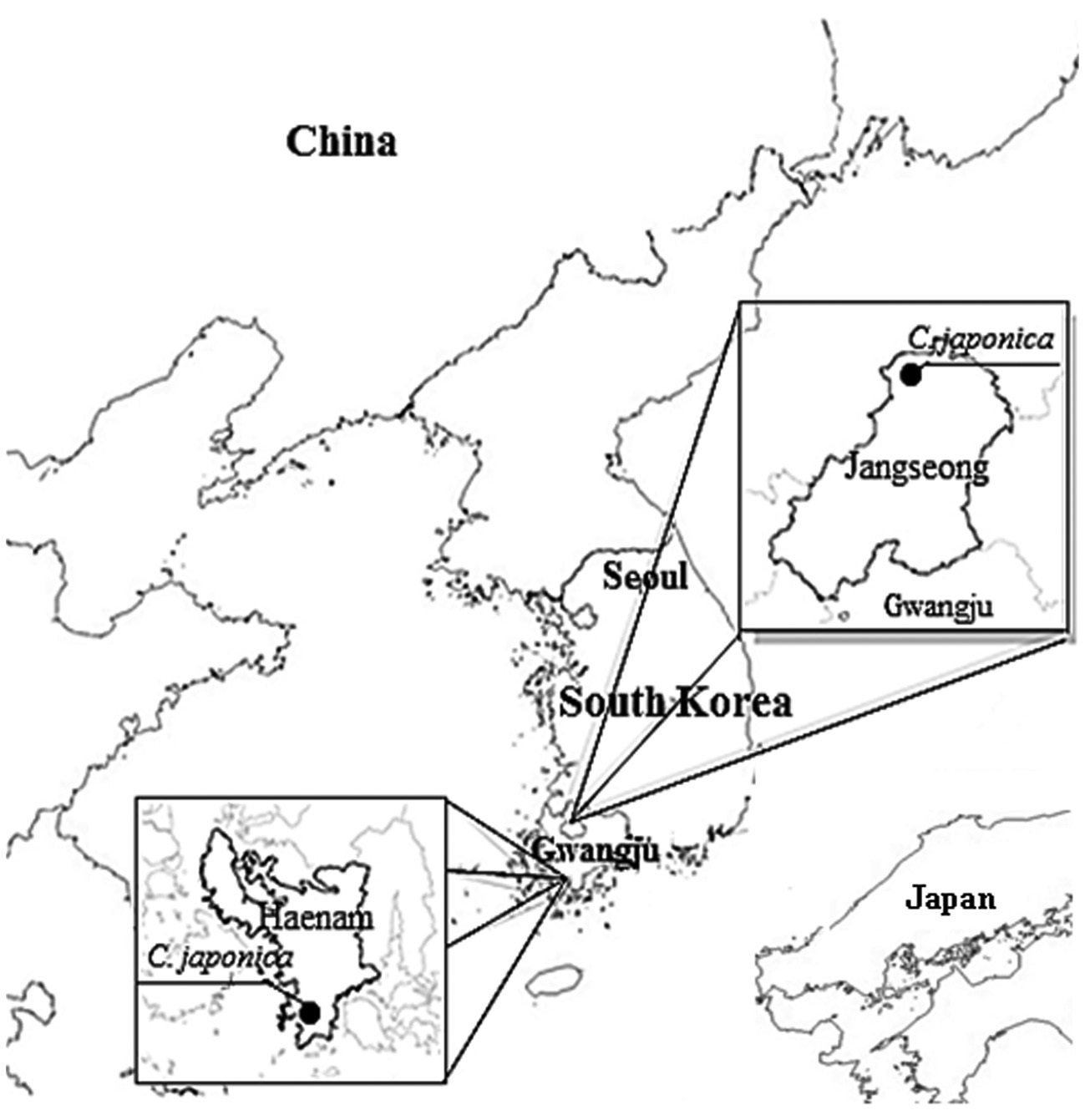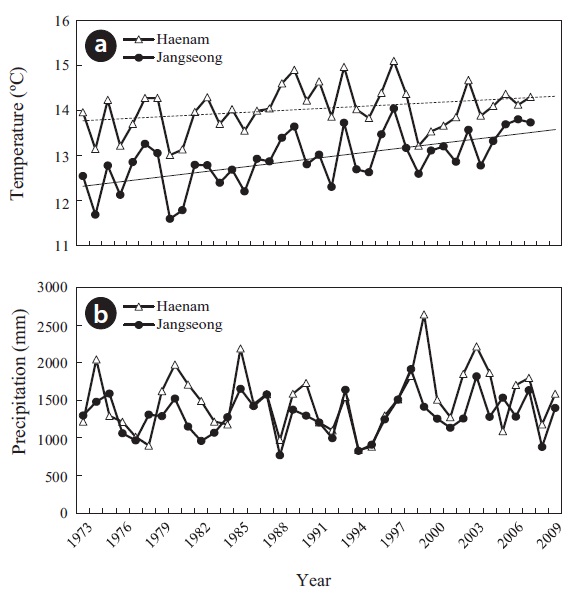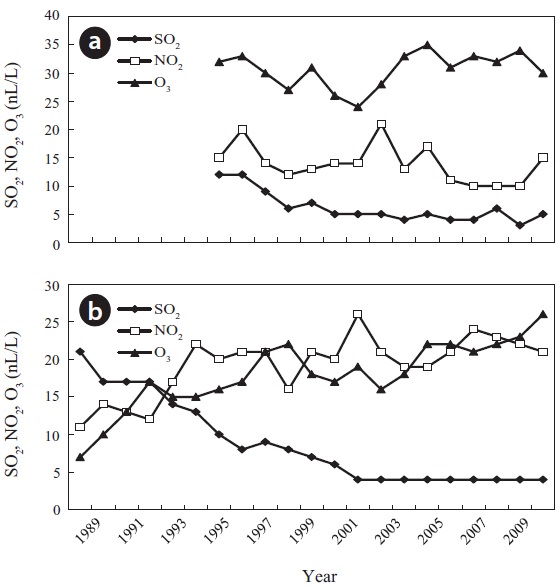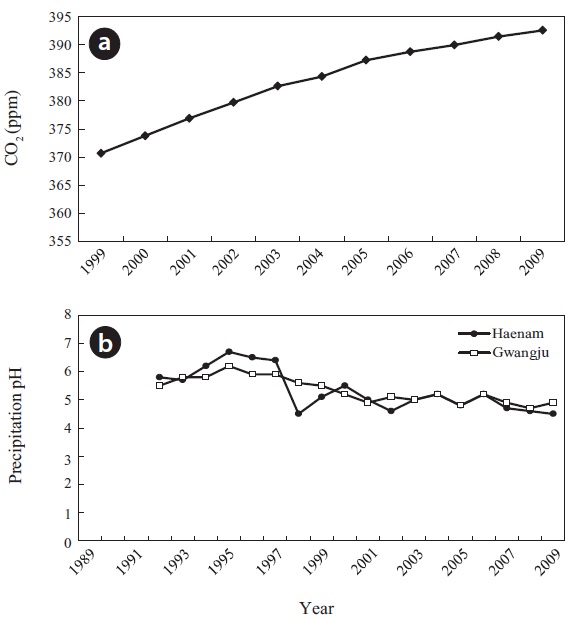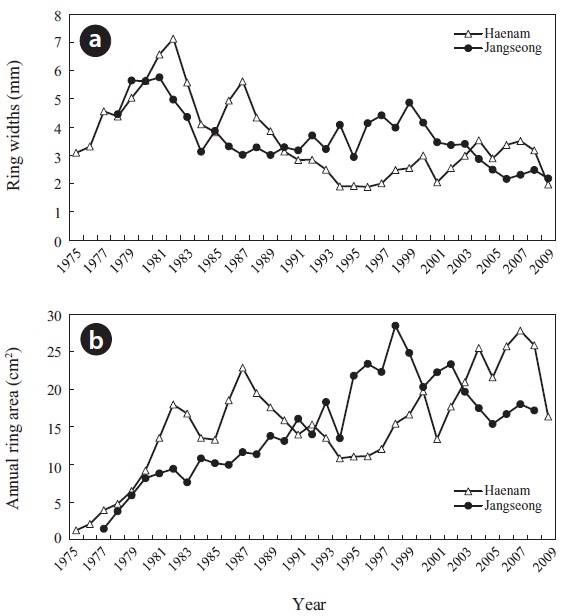



Tree growth is affected by various environmental changes such as increased atmospheric CO2 concentration, temperature, atmospheric pollution, and nitrogen deposition (Chmura et al. 2011, Ito et al. 2011). The effects of these environmental factors on tree growth have been studied worldwide. Forest decline in Asia has been linked to acid precipitation (Hirano et al. 2007), air pollution and global warming (Woo 2009).
Impacts of atmospheric NO2 concentration on forest decline of
In Korea, tree ring formation and growth are considered useful sources of information for understanding the effects of environmental changes. Historical changes in tree growth can be evaluated from annual ring area as better tree growth produces a larger ring area. A few studies have already investigated relationships between annual ring growth and environmental changes in temperature, precipitation pH, and atmospheric pollution for
In this study, environmental factors that constrain or stimulate annual tree-ring growth of
The objective of this study was to compare annual tree ring growth at two study sites in South Korea. The effects of climate factors (temperature and precipitation) and air pollution (acid precipitation, NO2, SO2, O3 and CO2 concentrations) on annual ring growth were examined.
[Table 1.] Characteristics of location and tree ring growth in the study sites

Characteristics of location and tree ring growth in the study sites
>
Description of the study sites
The study was performed at two sites: Haenam (34˚21′28″N, 126˚33′38″E) and Jangseong (35˚27′19″N, 126˚47′01″E) in southern Korea (Table 1, Fig. 1). The soil at these sites is classified as shallow gravelly silt loam with thin brown to dark brown color (Rural Development Administration of Korea 2000) with an average pH of 4.80 in Haenam (range: 4.66 to 4.98) and 4.35 in Jangseong (range: 4.30 to 4.44); total C concentration of 26.24 g C kg?1 in Haenam (range: 17.55 to 47.65) and 32.72 g C kg?1 in Jangseong (range: 8.40 to 78.84); total N of 2.32 g N kg?1 in Haenam (range: 1.34 to 3.82) and 3.09 g N kg?1 in Jangseong (range: 1.32 to 6.18) (Table 2).
The dominant understory vegetation at the study sites were
The environmental data set used for the correlation analysis included climate variables (temperature and precipitation), atmospheric pollutants (NO2, SO2, O3, and CO2), and precipitation pH. At each study site, all the meteorological and environmental monitoring data were obtained at two monitoring stations. For Haenam, climate variables were obtained from the Wando monitoring station located 14 km from the study site; atmospheric pollutant concentrations were obtained from the Mokpo monitoring station. In Jangseong, atmospheric pollutant concentrations were obtained from the Gwangju monitoring station, while climate variables were obtained from the Jeongup monitoring station, which is 14 km from the study site (Ministry of Environment of Korea 2010). During the 37 year period between 1973 and 2009 for which climate data are available, the mean annual temperature and precipitation were 14.0℃ and 1496.7 mm, 13.0℃ and
[Table 2.] Soil chemical properties in the study sites

Soil chemical properties in the study sites
1304.1 mm in Haenam (Wando), Jangseong (Jeongup), respectively (Fig. 2).
At Haenam (Mokpo) station between 1995 and 2009, mean annual SO2 concentration decreased from 12.0 to 4.0 nL L?1, while mean annual concentrations of NO2 and O3 fluctuated between 10.0 and 20.0 nL L?1 and between 24.0 and 35.0 nL L?1, respectively (Fig. 3a). At Jangseong (Gwangju) station, atmospheric pollutant concentration data were available from 1989 to 2009. During this period, mean annual SO2 concentration decreased from 21.0 to 4.0 nL L?1, while mean annual concentrations of O3 and NO2 increased from 7.0 to 26.0 nL L?1 and from 11.0 to 21.0 nL L?1, respectively (Fig. 3b).
At Gwangju station, atmospheric CO2 concentration increased from 370.7 ppm in 1999 to 392.5 ppm in 2009 (Fig. 4a). The mean precipitation pH at two sites showed a decreasing trend from 5.8 to 4.5 in Haenam (Mokpo) and from 5.5 to 4.9 in Jangseong between 1992 and 2009 (Fig. 4b).
A 20 × 20 m plot was established at each study site and randomly selected trees were cut down to collect tree-ring disks (Table 1). Three tree-ring disks were collected at breast height at each site. The ages of tree disks at the study sites were determined and ranged from 35- to 37-years old in Haenam, and from 32- to 34-years old in Jangseong.
Tree ring samples were sanded and polished to measure
the ring width. The ring width measurement was based on four radii for each disk sample. The radii were crossdated to identify to exact year in which each tree ring was formed (Baillie and Pilcher 1973). The ring widths of the disk were measured along each radius with an accuracy of 0.01mm, using the program CDendro and CooRecorder 7.4 (Cybis Elektronik and Data AB, Salsjobden, Sweden). The annual basal area increments were calculated assuming that tree rings are concentric circles to minimize agerelated growth trends of ring width and were used as an indicator of tree growth (Choi et al. 2007). The annual ring growth was calculated as an average for each region.
Response and correlation function analysis (Blasing et al. 1984) was used to examine relationships between annual ring growth and climate variables (temperature and precipitation), atmospheric pollutants (SO2, NO2, O3, and CO2), and precipitation pH (Kwak et al. 2011). Response function analysis is a form multiple regression. Because variation in annual ring width was likely to be affected by multiple environmental factors, these relationships were explored by Pearson correlation analysis.
All the response and correlation functions were determined for the period 1973?2009, which was common to both tree-ring data and the regional climate records. For relationships between air pollutants and annual ring area, the response and correlation functions were determined
for SO2, NO2, and O3 from 1995 in Haenam, and 1989 in Jangseong, for precipitation pH from 1992 in Haenam and Jangseong, for CO2 concentration from1999 at both sites. Therefore, the determination of these relationships was conducted using annual data.
All statistical analyses were performed using SPSS 11.5 statistical software package (SPSS, Chicago, Illinois, USA). The level of significance for all statistical tests was an α value of 0.05. The significance of annual trends of tree ring growth was assessed by the analysis of time series using year as an independent variable.
>
Variation in annual ring growth
Annual ring growth rates among the two sites were not significantly different (
Annual ring area in the all sites increased over time (
>
Relation of environmental factors with annual ring growth
Annual ring growth in Jangseong was positively correlated (
The effects of atmospheric pollutants such as acid precipitation, NO2, SO2, O3 and CO2 on the tree-ring growth differed between sites. Annual ring growth in Haenam was negatively correlated with SO2 concentration (
Inter-correlations of annual ring area (y) with air pollution and acid precipitation were assessed using linear correlation for multiple regressions at the two sites. In Jangseong, y was positively correlated with CO2 and NO2 (y = - 0.47 CO2 ? 0.61NO2 + 212.77,
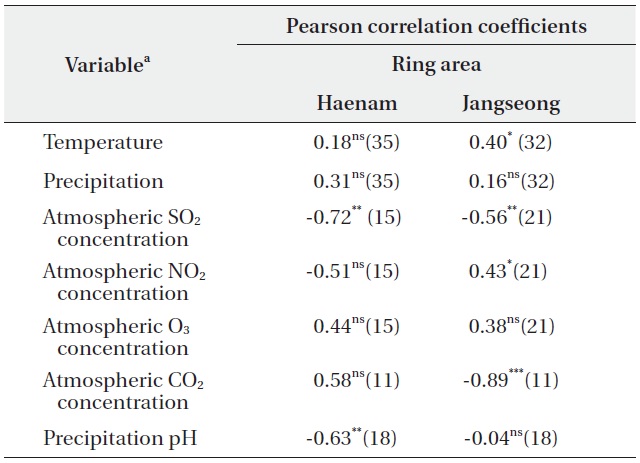
Pearson correlation between annual ring area and environmental variables in the study area
Annual ring growth varied markedly among the trees (n = 3) at each site, but the increment in annual ring growth was not different between sites (n = 2) (Fig. 5, Table 1). This suggests that variation in annual ring increment of individual trees depends on the environmental factors at each site such as climate, air pollution, and soil fertility. A positive correlation of temperature with annual ring area increment of trees in Jangseong was suggested that annual ring growth increased with increasing temperature. Lebourgeois et al. (2005) suggested that the positive effect of increased temperature on tree-ring growth might be related with soil water capacity. In Jangseong, mean annual precipitation was 1,304 mm (Fig. 2b), but this was not correlated with annual ring area. Thus, this site might have adequate moisture for tree growth. However, the lack of correlation between temperature and precipitation at this site may be due to the periods of water limitation (Savard 2010). Temperature changes between 1973 and 2009 were about from 0.1℃ to 1.5℃ which were about 1℃ lower comparing to temperature in Haenam (Fig. 2a). Increases in temperature might be directly affecting tree growth and indirectly through interactions with other stressors and disturbances (Chmura et al. 2011), but at Haenam, tree growth was not affected by temperature. The correlation between temperature and annual ring area in Jangseong has analyzed the regression model. Temperature has been claimed to be relatively unimportant for tree growth. Increase in tree growth in Jangseong may be extending the combination of increases in nitrogen deposition, CO2 concentration, and temperatures (Hyvonen et al. 2007, Bytnerowicz et al. 2007).
There were significant correlations between atmospheric pollutants and annual tree-ring growth at Haenam and Jangseong. The negative correlation between SO2 concentration and mean annual ring increment in Haenam and Jangseong (Table 3) suggested that annual ring growth increased with decreasing SO2 concentration. In a previous study, decreases in atmospheric SO2 concentration due to national policy were not considered high enough to affect tree growth (Kume et al. 2000). Therefore, the significant effect of SO2 concentration on increased growth of annual ring area in Haenam and Jangseong could be due to the acid deposition (Kwak et al. 2011). A significant relationship between NO2 concentration and annual ring area of trees in Jangseong (Table 3) could be attributed to annual ring area increment increasing with NO2. In an earlier study, the rate of forest decline of
For regression analysis at Jangseong, the combination of both CO2 and NO2 concentrations was positively correlated with annual ring area; this correlation suggested that annual ring growth increased with increased CO2 and elevated nitrogen deposition (Bytnerowicz et al. 2007). N deposition originated from NO2 (Kwak et al. 2011, Bytnerowicz et al. 2007) is claimed to be the most important factor of the increased tree growth. In effect, total N concentration in soil in Jangseong was 3.09 g kg-1 and it was higher than that in Haenam (Table 2); this may be the reason why annual ring widths in this site were larger than that in Haenam. Increased CO2 could lead to stomata closure to protect the plant from air pollution (Bytnerowicz et al. 2007). Therefore, integrated effects of elevated CO2, N deposition and climate changes on tree growth may be linked to acid deposition (Bytnerowicz et al. 2007) because of soil acidification with an average pH of 4.35 (Ito et al 2011) in Jangseong.
Acid deposition is formed from NO2, SO2, and O3 due to the burning of fossil fuels. At Haenam, the negative correlation between precipitation pH and annual ring area (Table 3) may reflect decreases in annual ring growth with increasing precipitation pH between 1992 and 2009. This correlation may also be linked to nitrogen deposition (Kwak et al. 2009b, Kwak et al. 2011) due to the H+ input from acid rain (Shan 1998).The nitrogen content from acid precipitation can be sufficient to stimulate tree growth (Shan 1998). The decreasing precipitation pH (Fig. 4b) may seem to reflected increased N deposition originated from NOx emission that is known to be depleted in 15N relative to the soil mineral N due to soil acidification (Kwak et al. 2011). The soil was acidic with pH of below 5.5 (Pritchett & Fisher 1987). In our study, mean pH value of soil in Haenam was 4.8 and total N concentration in soil was 2.32 g kg-1 (Table 2), and leaching of nutrients at this site with the acid deposition may result in changes in growth (Ito et al. 2011). Long-term acid deposition may also have altered forest structure and function (McNulty and Boggs 2010). The effect of increased precipitation acidity on decreased tree ring growth may be attributed to changes in forest nutrient cycles such changed soil nitrogen dynamics (Choi et al. 2007). The significant correlation between precipitation pH and annual ring area in Haenam also suggests that tree ring data might be useful as an indicator of precipitation pH. Kwak et al. (2009b, 2011) also suggested that tree ring chemistry of
1. At two study sites in southern Korea, annual ring growth of
2. At all sites, the annual tree-ring growth was affected by integration of climate change and atmospheric pollutants in the forest ecosystem of Jangseong. The positive correlations of temperature and NO2 concentration with annual ring growth of trees could suggest that the ring growth increased with increasing temperature and nitrogen deposition in Jangseong. In addition, the negative effects of SO2 and CO2 concentrations on tree-ring growth might be reflected in the increase in annual ring area with decreased atmospheric SO2 and CO2 concentrations due to national policy and the respiration of plants by inhibiting photosynthesis in Jangseong. Therefore, the majority of increased annual ring growth of trees in this site could interact among increased temperature, nitrogen deposition, and CO2. However, effects of atmospheric SO2, NO2, CO2 on annual growth rings were affected by air pollution in forest ecosystem. The combination of effects of atmospheric pollutants and temperature changes on tree growth might be the problem of acidification in the forest ecosystem of Jangseong.
3. In Haenam, a negative correlation of tree-ring growth with SO2 and precipitation pH might be reflected in the nitrogen deposition, and these correlations may be changes in forest nutrient cycles caused by the acid rain. Precipitation pH affected the annual growth of trees in Haenam and annual ring growth might be useful as an indicator to estimate precipitation pH.
4. These results suggested that annual ring growth of

